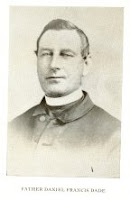 With full disclosure, our Advent/Christmas Annual Concert title is a misnomer, though it’s meant as a quaint and humble homage to our founder. Though it’s hard to imagine, Christmas music, carols especially, have proven not to be the centerpiece of sacred seasonal concerts of a hundred-years yore.
With full disclosure, our Advent/Christmas Annual Concert title is a misnomer, though it’s meant as a quaint and humble homage to our founder. Though it’s hard to imagine, Christmas music, carols especially, have proven not to be the centerpiece of sacred seasonal concerts of a hundred-years yore.
We have endeavored to reconstruct a facsimile of “American” Roman Catholic music as it was practiced and heard during the years of Fr. Dade’s formation and service in Philadelphia, and what of that repertoire might have eventually emigrated with him to California, Visalia and St. Mary’s. In addition, we have researched period catholic hymnals of the mid to late 19th century for carol texts, Spanish-language “villançicos” and other song forms that would have likely been sung during Fr. Dade’s tenure as Visalia’s pastor.
Virtually the only musical forensic evidence in Fr. Dade’s biography, THE APOSTLE OF THE VALLEY, denotes that “entertainments” that included music and dance benefited the building of the second church building in 1872 and that the parish did have an organist/music teacher for the parish school children. Speculation about exact musical pieces is all that remains from that. However, the book states “, “Music was provided by a quartet who went in a special conveyance from Visalia; they rendered ‘Peter’s Mass in D’ ‘ in a beautiful and impressive manner.”
Thanks be to God, the very pleasant agents of the Library of Congress and the University of Louisville, we were able to locate that very Mass setting and secure copies. Before discussing this work and others, I must also give great appreciation to my colleagues Ed Teixeira (Organist/Director-St. David’s, Richmond CA), Dr. Doug Shadle, (Musicologist at the U. of Lousiville), and Dr. Mike O’Connor, (Musicologist of Palm Beach Atlantic University), for providing veins of sheer gold for me to mine.
The “Peter” of the “Mass in D Major” was composed by Williams Cummings Peters, whose personal history is associated with the great Stephen Foster. Peters was a noted Catholic choir director who also compiled and published a number of catholic hymnals that bore striking resemblance to the forms of denomination hymnals of that era, using the terms “Harmonist” and “Harp,” as in the famed “Sacred Harp” school of shape note singing used for worship and music literacy. Peters’ Mass is grounded in a sort of Hadyn meets Mozart European style. The two movements from the Mass that we will perform are the Gloria (most appropriate as it is the hymn the angels sang to the newborn Christ at His Nativity) and the Agnus Dei (Lamb of God.) The Gloria contains a pastiche of melodic “scenes” which could lightly be called “text painting.”
Another great “find” was an emigrant German Philadelphian composer, Albert RoSewig (b.1846) who had many Victorian-era hymns, carols and motets. The choir will sing my arrangement of his setting of the AVE MARIA, as well as his setting of a Communion motet “O Salutaris Hostia” and another period piece for Christmas.
An amazing piece that we will feature is yet another Philadelphian, J. Remington Fairlamb’s “Great” TE DEUM, a hymn of praise sung at the New Year and at great feast days. This piece is significant in that Fairlamb uses English rather than Latin (unusual for the era) and for some compelling musical harmonic devices that are unique to my ear. Fairlamb was designated by Abraham Lincoln to be a consul to Switzerland as well!
More traditional carols such as “Adeste Fideles” and “What Child is This?” we have located in the “Young Catholic’s Hymnal” circa 1870 that contain verse lyrics that are stunningly different than those we sing today. We will enjoin the audience in the singing of these “discovered” texts.
As mentioned earlier, the choirs will also sing Christmas “villançicos.” These are a hybrid form of European polyphonic motets with native (Nahuatal) folk idioms of the post-conquisition and missionary era in Mexico. They are incredibly beautiful Spanish “carols.” Though there is no evidence that this music was sung in St. Mary’s, there is plenty of evidence they were sung daily across the central coast range in the Franciscan missions in this era.
And we will be joined by our own Gregorian Schola of St. Francis, led by Ralph Colucci, for a selection of Advent, Nativity and Epiphany proper chants that were hopefully sung by the children’s choir in those pioneer times.
We hope the entire Visalia music-loving community will join us at 4pm, December 18th for our “antique” concert celebrating our history.

It sounds like a wonderful event, and a good excuse to do Catholic music no longer done. (RoSewig — the capita S was so the 2nd syllable would get pronounced, German-style — was on the Society of St. Gregory's blacklist) But English Te Deums were quite common, as part of Anglican Morning Prayer; do you have one of these, or is there a definite Catholic connection? In any case, good luck!
Thank you, jq, Montani did indeed take his fellow Philadelphian to task, and not without reason. RoSewig's AVE MARIA is not unlike a university fight song, so I'm going to take some liberties with rythmic values and tempi, and dress up some of the cadences to lessen some of the coarser chromatic motifs.
Thanks for the comment.
This is pretty exciting. I hope those of us far from Visalia will get a chance to hear some of this!